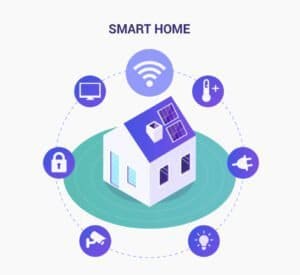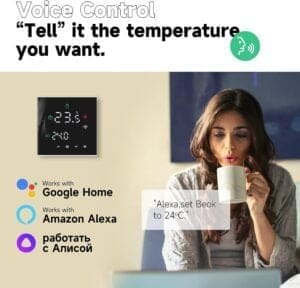Imagine coming home after a long day at work and your house is already at the perfect temperature, your lights are on, and your favourite music is playing softly in the background. All of this is possible with the advent of smart homes. These innovative technological systems not only provide convenience and comfort, but they also help save energy and reduce costs. Through the integration of smart thermostats, energy-efficient appliances, and intelligent lighting systems, homeowners have greater control over their energy consumption, leading to significant savings on utility bills. In this article, we will explore how smart homes are revolutionizing the way we live, making our lives easier, more sustainable, and more cost-effective.
Definition of Smart Homes
Overview of smart home technology
Smart homes are houses that are equipped with advanced technologies and connected devices that allow for greater control, convenience, and energy efficiency. These technologies enable homeowners to automate and remotely manage various household systems and appliances, creating a seamless and intelligent living environment. With the integration of smart home technology, everyday tasks can be simplified and energy consumption can be optimized, resulting in lower energy bills and a greener home.
Key features of a smart home
The key features of a smart home include connectivity, automation, and intelligence. Connected devices such as sensors, thermostats, lighting systems, and appliances enable communication and integration between different components of the house. Automation allows for the scheduling, programming, and synchronization of various devices and systems, making them work together seamlessly. The intelligence aspect comes from the ability of smart home systems to learn, adapt, and make data-driven decisions to optimize energy consumption and enhance the overall living experience.

Benefits of smart home technology
Smart home technology offers numerous benefits to homeowners. One of the most significant advantages is increased energy efficiency, which can lead to substantial cost savings on energy bills. By automating and optimizing the use of lighting, heating, cooling, and appliances, smart homes can significantly reduce energy wastage. Additionally, smart homes enhance convenience and comfort by allowing personalized control and customization of various household systems. The integration of security and surveillance systems also provides enhanced safety and peace of mind. Moreover, smart homes can increase the value of properties and may also be eligible for incentives, rebates, and tax credits for energy-efficient upgrades.
Energy Efficiency in Smart Homes
Introduction to energy efficiency
Energy efficiency refers to the ability to use energy in a more economical and sustainable manner, without compromising comfort or convenience. In the context of smart homes, energy efficiency is a core principle that guides the design and operation of various systems and appliances. By employing energy-efficient technologies, homeowners can reduce their carbon footprint, conserve natural resources, and lower their energy consumption.
Energy-saving devices and appliances
Smart homes integrate energy-saving devices and appliances that are designed to minimize energy consumption without sacrificing functionality. Energy-efficient LED bulbs, for example, consume significantly less energy than traditional incandescent bulbs while providing the same or even better lighting quality. Similarly, smart appliances such as refrigerators, washing machines, and dishwashers incorporate advanced technologies that optimize energy usage, reducing electricity and water consumption.
Integration of renewable energy sources
Smart homes can also harness the power of renewable energy sources such as solar panels and wind turbines to generate electricity. By integrating these renewable sources into the house’s energy supply, homeowners can reduce their reliance on grid electricity and lower their carbon emissions. Smart home systems can intelligently manage the production, storage, and usage of renewable energy, ensuring optimal utilization and maximizing cost savings.
Automated energy management systems
Automated energy management systems play a crucial role in achieving energy efficiency in smart homes. These systems utilize advanced algorithms and sensors to monitor energy usage patterns and optimize the operation of different devices and systems accordingly. For example, they can automatically adjust the temperature settings of heating and cooling systems based on occupancy, time of day, and weather conditions. By continuously analysing data, these systems can identify energy wastage and make real-time adjustments to minimize energy consumption.

Smart Lighting and Home Automation
Energy-efficient LED bulbs
Smart lighting systems in smart homes often utilize energy-efficient LED bulbs. LED bulbs consume significantly less energy compared to traditional incandescent bulbs and have a longer lifespan. Additionally, LED bulbs offer greater versatility and customization options, allowing homeowners to adjust colour temperature, brightness levels, and even create lighting scenes according to their preferences. By upgrading to LED bulbs, energy usage can be substantially reduced without compromising lighting quality.
Motion sensors and occupancy detection
Motion sensors and occupancy detection play a key role in smart lighting systems. These sensors can detect motion in a room and automatically turn on lights when someone enters, eliminating the need for manual switch operation. Occupancy detection further enhances energy efficiency by automatically turning off lights when a room is unoccupied. These features ensure that lights are only used when needed, reducing unnecessary energy consumption.

Lighting automation for optimized usage
Smart lighting systems in smart homes often incorporate lighting automation capabilities. Homeowners can schedule lights to turn on and off at specific times or create lighting scenes for different activities or moods. For example, lights can automatically dim in the evenings to create a cozy atmosphere or turn off when everyone leaves the house. By automating lighting, energy wastage can be minimized, and energy consumption can be optimized based on specific usage patterns and preferences.
Remote control and scheduling
Smart lighting systems also offer remote control and scheduling functionality. With the use of mobile apps or voice commands, homeowners can control the lighting in their homes from anywhere. This allows for greater convenience and flexibility, enabling lights to be turned on or off remotely or adjusted according to changing needs. Scheduling features also allow lights to be programmed to turn on or off at specific times, ensuring energy efficiency and security even when homeowners are away.
Thermostat and Heating Control
Programmable thermostats for efficient heating
Programmable thermostats are a common feature in smart homes and play a vital role in optimizing heating efficiency. These thermostats allow homeowners to set specific temperature schedules for different times of the day or week. By programming the thermostat to lower the temperature when the house is unoccupied or during sleeping hours, energy consumption can be reduced without sacrificing comfort. Additionally, programmable thermostats can adapt to occupancy patterns and make adjustments accordingly, further optimizing heating efficiency.
Smart thermostats and learning capabilities
Smart thermostats take heating control to the next level by leveraging advanced technologies and learning capabilities. These thermostats can learn the homeowners’ preferences, occupancy patterns, and temperature preferences over time, adjusting the temperature settings automatically to maximize comfort and energy savings. Some smart thermostats can even be controlled remotely via mobile apps, allowing homeowners to manage heating systems from anywhere. By combining automation, learning capabilities, and remote control, smart thermostats offer unparalleled convenience and energy efficiency.

Zoning systems and personalized comfort
Zoning systems in smart homes enable personalized heating control by dividing the house into multiple zones with independent temperature controls. This allows homeowners to heat specific areas of the house individually based on occupancy and usage patterns. For example, unused rooms or areas can be kept at a lower temperature, while frequently used areas can be heated to the desired comfort level. By providing personalized comfort and avoiding unnecessary heating, zoning systems contribute to significant energy savings.
Integration with weather forecasts for intelligent control
Smart thermostats in smart homes can be integrated with weather forecasts to optimize heating control. By considering external temperature conditions, humidity levels, and weather forecasts, these thermostats can adjust the indoor temperature settings accordingly. For example, if a particularly sunny day is expected, the thermostat can lower the heating to account for the additional warmth from the sun. This intelligent control ensures optimal heating efficiency and reduces energy wastage.
Smart Appliances and Energy Monitoring
Energy-efficient appliances in smart homes
Smart homes incorporate energy-efficient appliances that are specifically designed to minimize energy consumption while maintaining optimal functionality. These appliances, such as refrigerators, washing machines, dryers, and dishwashers, utilize advanced technologies and features that optimize energy usage. For example, some smart appliances have energy-saving modes, load detection capabilities, or can be programmed to run during off-peak hours when electricity rates are lower. By using energy-efficient appliances, homeowners can significantly reduce their energy consumption and lower their utility bills.
Smart plugs and power monitoring devices
Smart plugs and power monitoring devices are essential components of energy monitoring in smart homes. These devices can be connected to appliances and measure their energy usage in real-time. By providing detailed information on energy consumption, homeowners can identify energy-intensive appliances or activities and make informed decisions to reduce their energy consumption. Additionally, smart plugs enable remote control and scheduling of appliances, allowing for greater flexibility and energy optimization.

Real-time energy consumption tracking
Real-time energy consumption tracking is a key feature of smart home systems. Homeowners can access real-time energy usage data through online portals or mobile apps, allowing them to monitor and analyze their energy consumption patterns. By having visibility into energy usage, homeowners can identify energy wastage, spot irregularities, and make changes to their habits or devices to achieve higher energy efficiency. Real-time energy consumption tracking promotes awareness and empowers homeowners to take proactive steps towards energy conservation.
Identifying energy-wasting patterns
Smart home systems can analyze energy consumption data over time to identify energy-wasting patterns or anomalies. By utilizing advanced algorithms and machine learning, these systems can detect irregularities or deviations from expected energy usage patterns and provide insights to homeowners. For example, they can identify energy spikes caused by appliances running inefficiently or determine when specific usage habits are contributing to excessive energy consumption. These insights enable homeowners to make adjustments, optimize energy usage, and further reduce their energy costs.
Optimized Water Usage
Smart watering systems for gardens
Smart watering systems are an excellent example of how smart home technology can optimize water usage. These systems utilize moisture sensors or weather data to determine the optimal irrigation needs of a garden or lawn. By automatically adjusting the watering schedule based on real-time conditions, smart watering systems prevent overwatering, reduce water wastage, and ensure that plants receive the right amount of water at the right time. By optimizing water usage, homeowners can conserve water resources and reduce water bills.
Leak detection and water consumption monitoring
Smart homes can employ leak detection systems and water consumption monitoring devices to prevent water wastage and detect potential leaks. These devices can monitor water flow and detect anomalies or sudden changes in water usage, triggering alerts to notify homeowners of potential leaks. By promptly addressing water leaks, homeowners can avoid unnecessary water loss, prevent property damage, and reduce water bills. Additionally, water consumption monitoring devices provide real-time data on water usage, allowing homeowners to track and optimize their water consumption habits.
Automated irrigation based on weather conditions
Smart home systems can integrate weather forecast data with automated irrigation systems to optimize water usage. By considering factors such as rain predictions, temperature, and humidity levels, the irrigation system can adjust the watering schedule accordingly. For example, if rain is expected, the system can skip watering, eliminating the need for manual adjustments. This automated irrigation based on weather conditions ensures that water is used efficiently and in line with the specific needs of the plants, conserving water resources and minimizing waste.
Water-saving fixtures and appliances
Smart homes can incorporate water-saving fixtures and appliances that help optimize water usage. Low-flow faucets, showerheads, and toilets reduce the amount of water consumed without compromising functionality or comfort. These fixtures utilize advanced technologies to maintain water pressure while reducing the flow rate. Smart washing machines and dishwashers also have features that optimize water usage, such as load detection, water level adjustment, and cycle optimization. By using water-saving fixtures and appliances, homeowners can significantly reduce their water consumption, conserve water resources, and lower their water bills.
Energy Management and Home Integration
Centralized control and coordination
Energy management in smart homes involves centralized control and coordination of various devices and systems. Centralized control allows homeowners to manage and monitor multiple devices from a single interface, such as a mobile app or a smart hub. This centralized control simplifies the management of energy consumption, enabling homeowners to monitor, adjust, and automate different aspects of their home’s energy usage. Coordination between devices, such as adjusting heating or cooling systems based on occupancy or lighting levels, further enhances energy efficiency and optimization.
Smart grids and energy demand response
Smart homes can be integrated into smart grids, which are advanced electricity distribution networks that enable real-time communication and coordination between electricity providers, consumers, and devices. Through the integration with smart grids, smart homes can participate in energy demand response programs. These programs allow homeowners to receive incentives or rebates for reducing their electricity usage during peak demand periods, contributing to grid stability and optimizing energy consumption.
Integration with renewable energy sources
Smart homes can be designed to integrate renewable energy sources such as solar panels or wind turbines. By generating clean and renewable energy on-site, homeowners can reduce their reliance on grid electricity and lower their carbon footprint. Smart home systems can communicate and optimize the usage of renewable energy sources, ensuring an optimal balance between energy generation and consumption. Integration with renewable energy sources contributes to increased self-sufficiency and sustainable energy practices.
Optimizing energy consumption based on utility prices
Smart home systems can analyse utility pricing information, such as time-of-use rates or dynamic pricing, to optimize energy consumption. By scheduling energy-intensive tasks such as laundry or charging electric vehicles during off-peak hours when electricity rates are lower, homeowners can reduce their electricity bills. Additionally, smart home systems can automatically adjust energy usage based on real-time pricing fluctuations, ensuring energy consumption aligns with the most cost-effective periods. By optimizing energy consumption based on utility prices, homeowners can achieve significant cost savings.
Smart Home Security Systems
Enhanced security with smart home technology
Smart home security systems provide enhanced security and peace of mind by integrating advanced technologies and devices. These systems include features such as smart locks, door/window sensors, motion detectors, and security cameras. By connecting these devices to a centralized control system, homeowners can remotely monitor and manage their home security. Smart home security systems offer increased convenience and functionality compared to traditional security systems, enabling real-time monitoring, instant alerts, and remote control from anywhere.

Integration with surveillance cameras and sensors
Surveillance cameras and sensors are vital components of smart home security systems. These devices capture and monitor the surroundings for any suspicious or unexpected activities. Surveillance cameras can be accessed remotely, allowing homeowners to monitor their property in real-time and receive alerts in case of intrusions. Sensors, such as door/window sensors or motion detectors, can detect unauthorized entry and trigger alarms or notifications. Integration with surveillance cameras and sensors enables comprehensive security coverage and enhances home security.
Energy efficiency through automation and alerts
Smart home security systems promote energy efficiency through automation and alerts. By integrating security devices with other household systems, such as lighting or heating, automation can ensure that energy is used efficiently and only when necessary. For example, when the security system detects that the house is unoccupied, it can automatically turn off lights or adjust temperature settings. Additionally, smart home security systems can send real-time alerts or notifications to homeowners’ mobile devices if security breaches are detected, allowing for immediate action and minimizing potential energy wastage.
Cost savings with smart insurance policies
Smart home security systems can also lead to cost savings through insurance policies. Many insurance providers offer lower premiums for homeowners who have installed sophisticated security systems. Smart home security systems provide an additional layer of protection and reduce the risk of theft or damage, making homeowners eligible for potential discounts on insurance policies. By investing in smart home security, homeowners not only gain enhanced security but can also realize long-term financial benefits through reduced insurance costs.
Financial Benefits of Smart Homes
Lower energy bills and cost savings
One of the significant financial benefits of smart homes is lower energy bills and cost savings. By optimizing energy consumption and reducing waste through automation, scheduling, and energy monitoring, homeowners can significantly lower their electricity, gas, and water bills. Smart home technology enables real-time tracking and analysis of energy usage, empowering homeowners to make informed decisions and adjust their habits to further conserve energy and reduce costs. The long-term savings on energy bills can be substantial and provide a significant return on investment for smart home technology.
Reduced maintenance and repair expenses
Smart home technology can also contribute to reduced maintenance and repair expenses. By integrating smart devices and systems, homeowners gain increased visibility and control over their home’s condition. For example, smart home systems can monitor the performance of HVAC systems, alerting homeowners to potential issues or the need for maintenance. This proactive approach allows homeowners to address problems early, preventing costly repairs or breakdowns. Additionally, smart devices such as leak detectors or surveillance cameras can detect issues such as water leaks or security breaches, enabling timely actions and minimizing potential damages and repair costs.
Increased property value and resale potential
Smart homes have shown to have increased property value and improved resale potential. Homebuyers are increasingly attracted to the convenience, comfort, and energy efficiency offered by smart home technology. By incorporating smart home features, homeowners can differentiate their properties in a competitive real estate market and potentially command higher selling prices. The added value of smart home technology can also make a property more appealing to a broader range of potential buyers, leading to a quicker sale and increased return on investment.
Incentives, rebates, and tax credits for smart home upgrades
Governments and utilities often provide incentives, rebates, and tax credits to encourage the adoption of energy-efficient technologies and smart home upgrades. These financial incentives can offset the initial costs of investing in smart home technology and make it more affordable for homeowners. Incentives and rebates can be offered for the purchase and installation of energy-efficient appliances, smart thermostats, solar panels, or other eligible smart home systems. Additionally, some jurisdictions may provide tax credits for energy-saving home upgrades, further reducing the overall cost of implementing smart home technology.
Conclusion
Smart homes offer numerous benefits in terms of energy efficiency, convenience, security, and financial savings. By leveraging advanced technologies and integrating smart devices and systems, homeowners can optimize their energy consumption, reduce their carbon footprint, and lower their utility bills. From smart lighting to energy management systems, every aspect of a smart home is designed to enhance energy efficiency and provide a comfortable and eco-friendly living environment. With the potential for cost savings, increased property value, and financial incentives, the adoption of smart home technology is an investment that pays off in the long run. As smart homes continue to evolve and become more accessible, homeowners are presented with the opportunity to create a greener, smarter, and more sustainable future.
